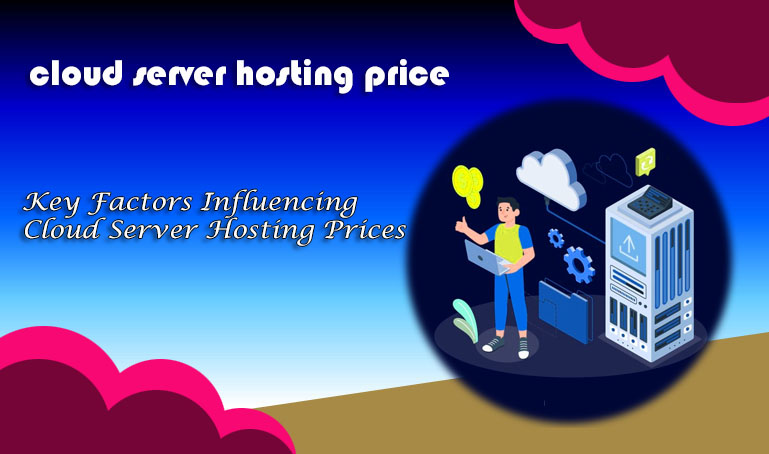Understanding Cloud Server Hosting Prices: What You Need to Know
In today’s digital landscape, cloud server hosting has become a cornerstone for businesses of all sizes. Cloud solutions’ flexibility, scalability, and cost-effectiveness make them an attractive choice over traditional on-premise servers.
However, understanding cloud server hosting prices can be challenging due to the variety of factors that influence them. This article aims to break down these factors, helping you make an informed decision about your business needs.

What is Cloud Server Hosting?
Cloud server hosting involves virtual servers running in a cloud computing environment. Unlike traditional hosting, which typically involves a single physical server, cloud hosting spreads your data across multiple servers. This setup provides redundancy, ensuring your website or application remains accessible even if one server fails.
Key Factors Influencing Cloud Server Hosting Prices
- Type of Cloud Hosting:
- Public Cloud: Amazon Web Services (AWS), Google Cloud Platform (GCP), and Microsoft Azure offer shared resources across multiple customers. This is typically the most cost-effective option.
- Private Cloud: Dedicated environments for a single organization, often used by businesses with specific security or performance requirements. This option is more expensive than the public cloud due to dedicated resources.
- Hybrid Cloud: This type of cloud combines public and private elements, allowing businesses to choose where to run their applications and workloads. Pricing can be complex, depending on the mix of services used.
- Resource Allocation:
- Compute The amount of CPU power required, often billed per hour. Higher-performance CPUs or more significant numbers of CPUs increase costs.
- Storage: Data storage requirements, including the type of storage (e.g., SSD vs. HDD) and the amount. Cloud providers charge based on the gigabytes or terabytes of storage used.
- Memory: RAM allocation is crucial for application performance. More memory typically means higher costs.
- Bandwidth and Data Transfer:
- Inbound Traffic: Generally free with most cloud providers.
- Outbound Traffic is often charged based on the amount of data transferred out of the cloud provider’s network. High-bandwidth applications, such as video streaming, can incur significant costs.
- Additional Services and Features:
- Managed Services: Some providers offer managed services, including database management, application monitoring, and security features, which can add to the cost.
- Support Levels: Basic support is usually free, but enhanced support with faster response times and dedicated account managers is available at an additional cost.
Comparing Cloud Providers: Cost Breakdown
To give a clearer picture of cloud server hosting prices, let’s compare the three leading cloud providers: AWS, GCP, and Azure.
Amazon Web Services (AWS): AWS offers various pricing models, including pay-as-you-go, reserved instances, and spot instances. For example, a t3.micro instance (1 vCPU, 1GB RAM) in the US East region costs approximately $0.0104 per hour. For storage, Amazon S3 charges around $0.023 per GB for the first 50 TB per month.
Google Cloud Platform (GCP): GCP’s pricing is similar to AWS. An e2.micro instance (2 vCPUs, 1GB RAM) costs about $0.0076 per hour. Google Cloud Storage charges $0.020 per GB for standard storage in the multi-region setting.
Microsoft Azure: Azure provides competitive pricing, focusing on enterprise needs. A B1s instance (1 vCPU, 1GB RAM) costs about $0.0076 per hour. Azure Blob Storage charges $0.0184 per GB for the first 50 TB in the hot tier.
Tips to Optimize Cloud Hosting Costs
- Understand Your Needs: Before choosing a provider, assess your business requirements, such as expected traffic, application demands, and data storage needs. This will help you select the right mix of services and resources.
- Choose the Right Pricing Model: Pay-as-you-go is flexible but expensive for long-term use. Reserved instances or committed use contracts offer discounts for long-term commitments.
- Utilize Cost Management Tools: Cloud providers offer tools to monitor and manage costs. AWS Cost Explorer, GCP’s Cost Management tools, and Azure Cost Management can help you track and optimize your spending.
- Leverage Auto-scaling: Auto-scaling automatically adjusts the number of running instances based on demand, ensuring you only pay for what you use.
- Take Advantage of Free Tiers and Credits: Most providers offer new customers free tiers and credits. Use these to test services and understand cost implications without financial risk.
Conclusion
Various factors, including the type of cloud hosting, resource allocation, data transfer needs, and additional services, influence cloud server hosting prices. By understanding these elements and carefully comparing the offerings of major providers like AWS, GCP, and Azure, businesses can find the most cost-effective solution for their needs.
Additionally, implementing cost optimization strategies can help manage and reduce expenses further. Making informed decisions about cloud server hosting can significantly impact your business’s bottom line, ensuring you get the best value for your investment.